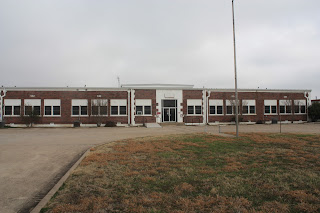"Lone Star Historian" is a blog about the travels and activities of the State Historian of Texas. Bill O'Neal was appointed to a two-year term by Gov. Rick Perry on August 22, 2012, at an impressive ceremony in the State Capitol. Bill is headquartered at Panola College (www.panola.edu) in Carthage, where he has taught since 1970. For more than 20 years Bill conducted the state's first Traveling Texas History class, a three-hour credit course which featured a 2,100-mile itinerary. In 2000 he was awarded a Piper Professorship, and in 2012 he received the Lifetime Achievement Award from the Wild West Historical Association. Bill has published almost 40 books, half about Texas history subjects, and in 2007 he was named Best Living Non-Fiction Writer by True West Magazine.
In Greenville last week I stopped at the Audie Murphy/American Cotton Museum. A few years ago, while working on a book entitled East Texas in World War II, I researched Audie Murphy in this museum. There is an imposing statue of Murphy - based on one of his combat exploits - on the approach to the museum.
Audie Leon Murphy was born on June 20, 1924 (or 1925) on a farm north of Greenville. He was the sixth of 12 children. His father was a sharecropper who deserted his poverty-stricken family in 1936. Audie's mother tried to hold her children together, and there were numerous moves around the area, once into an abandoned boxcar. Dropping out of school, Audie worked on farms for a dollar a day - when he could find employment. He hunted the woods for rabbits and squirrels, developing a feel for terrain. Hunting with a single-shot .22 rifle, Audie became a crack shot - if he missed, there was no meat in the family pot.
 |
| The old Greenville Post Office |
Audie's mother died in 1941. Audie found a job at a gas station in Greenville, while younger siblings were placed in Boles Children's Home, a Christian orphanage in Quinlan. After the attack on Pearl Harbor Audie tried to enlist, but he was underage and - at 5'5' and 110 pounds - undersized. But on his 18th (or 17th!) birthday in 1942 Audie was accepted by the U.S.Army, enlisting at Greenville's Post Office, which still stands just west of downtown.
He fought with courage and skill in Sicily, Italy, France, and Germany, suffering three wounds and taking part in amphibious assaults in Sicily and southern France. Awarded a battlefield commission, Lt. Audie Murphy won the Medal of Honor during an action near Holtzwihr, France, on January 26, 1945. Murphy's Company B was attacked by six tanks and a large infantry force. Ordering his men to return to prepared positions in nearby woods, Lieutenant Murphy remained forward while giving fire directions to artillery by telephone. Many advancing Germans halted, but the enemy tanks lumbered toward his position. Murphy climbed on a burning tank destroyer, which had been disabled by a shell and was in danger of blowing up, but Murphy manned the .50 caliber machine gun and turned the attack, mowing down an enemy squad that crept within 10 yards of him. Exposed atop the destroyer, he was wounded in the leg but killed or wounded 50 Germans. Refusing medical attention, Murphy organized a counterattack against the retreating Germans.
The most decorated American soldier of World War II, Murphy was presented 33 awards, including every medal the United States offers for valor - two of them twice. After the war, Murphy was invited for a long stay at the Hollywood home of movie star James Cagney. Pursuing a movie career, Murphy starred in Westerns, and in the 1956 hit To Hell and Back, the story of his combat career. For several years, he simultaneously served the Texas National Guard. In 1953, during the Korean War, Captain Murphy worked as a firearms instructor with members of the 36th Division T-Patchers ("The Texas Army"). Murphy hoped to accompany them to Korea, but the division was not deployed. Although promoted to major, Murphy concentrated on his film career. At 46 in 1971, he was killed in a plane crash and buried with full military honors at Arlington National Cemetery.
 |
| The old school at Floyd |
 |
| Murphy's statue stands outside the training center at Camp Mabry in Austin. |
For more information:
www.cottonmuseum.com
www.cottonmuseum.com
















.JPG)
.JPG)
.JPG)
.JPG)
.JPG)
.JPG)
.JPG)













